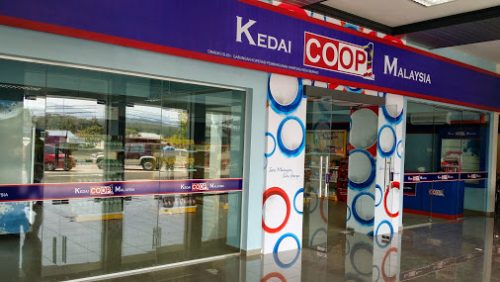- RM50 billion revenue target from co-op movement by 2020
- Securities Commission and Bank Negara Establish Group to Accelerate Digitisation of Stockbrocking Industry
- MAS Survey showed private sector economists expect higher growth for Singapore’s economy this year
- Singapore’s Labour Market Improved in 2017
- Singtel enhances connectivity to North Asia with Southeast Asia-Japan 2
- ASTRO Malaysia will feature new In-Stream Video Programming on Twitter
 RM50 billion revenue target from co-op movement by 2020
RM50 billion revenue target from co-op movement by 2020
The Malaysia Co-operative Societies Commission (SKM) is targetting a revenue contribution of RM50 billion from the co-operative movement nationwide by 2020. Executive Chairman, Datuk Dr Noor Zari Hamat, said the country’s co-operative movement had achieved encouraging growth last year compared with 2016. “The co-operative sector’s turnover recorded a growth of 0.9 per cent to RM40 billion (2017) compared with RM39.66 billion previously.” “Achieving that target required the aggressive co-operative participation nationwide,” he told reporters in Kuala Lumpur. Datuk Dr Noor Zari added that the co-operatives in the country could be further expanded based on the experience of the co-operative management in developed countries such as in Denmark, where co-operatives control 35 per cent of the retail and wholesale sector.
Securities Commission and Bank Negara Establish Group to Accelerate Digitisation of Stockbrocking Industry
The Securities Commission Malaysia and Bank Negara Malaysia today established the Brokerage Industry Digitisation Group (BRIDGe), a joint working group between the regulators and industry to accelerate digitisation of the stockbroking industry. BRIDGe aims to accelerate the digitisation of the brokerage industry to enhance operational efficiencies and service standards. The group will encompass the SC, BNM, and the industry participants including the brokers and banking institutions. The Central Bank said the SC and BNM share a common aim to drive digitisation within the Malaysian financial industry. There are opportunities to innovate across the intermediation value chain and reduce cost in both the brokerage and banking sectors. Therefore, it is important for the regulators to collaborate with industry to create greater value for the customers, as well as for the long-term development of the market.
Analysts raise Singapore’s 2018 GDP growth forecast to 3.2%
An outperformance in the electronics sector is predicted to boost the Singapore economy but economists are increasingly concerned about the risk of a global trade war. Private sector economists are pencilling in higher growth for Singapore’s economy this year, the latest quarterly survey from the Monetary Authority of Singapore (MAS) showed. Economic growth for 2018 is expected to come in at 3.2 per cent, according to the 24 economists and analysts polled. This is up from an earlier 3 per cent forecast in December. For next year, expectations are for Singapore’s gross domestic product (GDP) growth to expand at a slightly slower rate of 2.8 per cent. This comes on the back of official data released last month, which showed the economy clocking faster-than-expected growth of 3.6 per cent for 2017 and the year’s final quarter. Official estimates tipped 2018 growth to come in slightly above the middle of the forecast range of 1.5 to 3.5 per cent, barring the materialisation of any downside risks.
Singapore’s Labour Market Improved in 2017
Singapore’s Ministry of Manpower said the country’s labour market improved in 2017, in line with the pick-up in economic activity. While the resident long-term unemployment rate held steady in December 2017, the unemployment rate declined from a year before. The Ministry said local employment growth in 2017 was nearly double that of 2016, while foreign employment declined more than it did the year before. There were also significantly fewer retrenchments and more job vacancies. At the same time, productivity growth was more than double that of 2016.
Singtel enhances connectivity to North Asia with Southeast Asia-Japan 2
Singtel and the members of the Southeast Asia – Japan 2 consortium (SJC2) today signed an agreement with NEC Corporation to build a high performance submarine cable connecting Singapore, Thailand, Cambodia, Vietnam, Hong Kong, Taiwan, mainland China, Korea and Japan. The 10,500-kilometre submarine cable links eleven cable landing stations in the region and is expected to be completed by the fourth quarter of 2020. The SJC2 will be built and operated by a global consortium comprising telecommunications and technology companies. The cable will feature up to eight pairs of high capacity optical fibre with a total capacity of 144 Terabits per second, roughly the equivalent of simultaneously streaming 5.76 million ultra-high definition videos per second. Its high capacity allows it to support the high bandwidth requirements of advanced technologies such as the Internet of Things, robotics, data analytics, artificial intelligence and virtual reality applications.
ASTRO Malaysia will feature new In-Stream Video Programming on Twitter
Twitter has introduced nine new premium video sports content partnerships to Asia Pacific advertisers. The move will add to the hundreds of sporting hours of live original programming, live games, highlights, and events to the platform. The announcement includes extensions of existing regional deals and brings more opportunities for advertisers in Asia Pacific to align their brand with premium sports video content. “Twitter is the best destination for sports video content because it’s an extension of what fans already expect from our platform — the live sports conversation unfolding on Twitter,” said Aneesh Madani, Head of Sport Partnerships, Asia Pacific, Twitter. “Asia Pacific is a growth engine for Twitter and we could not be prouder to extend our success with more In-Stream premium video content from both headline events, and exciting underserved content, from sports leagues across the region.”
























